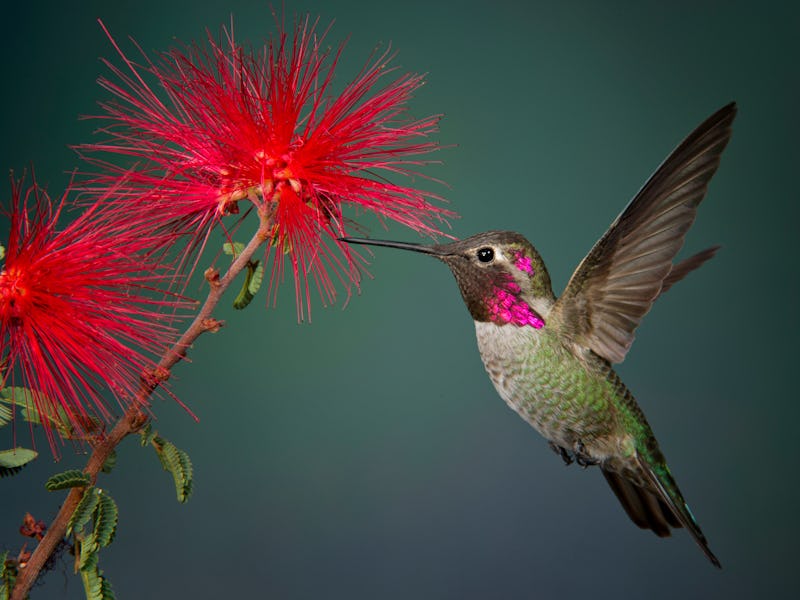Can hummingbirds survive climate change? Scientists say it's complicated
New climate change research could spell bad news for hummingbirds.

Between November and May, Anna’s hummingbirds, a common hummingbird species on the west coast of the US, come out to play in the lowlands of California before migrating to higher altitudes during the summertime. These tiny red-and-green creatures span the entire West Coast from Baja California all the way up to British Columbia.
But as Earth warms and global temperatures continue to rise, it’s possible these fast-whizzing birds will have a harder time escaping to higher elevations, new research reveals. The findings were published Thursday in the Journal of Experimental Biology.
Here’s the background — Scientists have observed animals and plants adapting to global warming by migrating toward the poles and higher elevations, seeking cooler temperatures as their native habitats grow too hot. Austin Spence, the lead author of the study and a conservation biologist and postdoctoral researcher at the University of California, Davis, likens this adaptation to using an air conditioner in hotter weather.
“Think of an AC. If I’m too hot, I can turn it down. If an animal or plant is too hot, they can’t turn the AC down,” Spence tells Inverse. But they can relocate to areas that have the kind of weather they are accustomed to, he says.
But species don’t always move in the direction we would expect as a result of the climate crisis. Factors other than temperature shifts — such as oxygen availability and air pressure — could impact whether animals are physiologically able to move to higher elevations.
Due to humans intruding into their habitats, Anna’s hummingbirds have already moved north from Southern California all the way up to Canada. Therefore, these birds can help scientists understand how animals could migrate to higher elevations in response to a changing environment.
“Anna’s hummingbirds are a great study system because they’ve already changed their life history because of humans,” Spence says.
What’s new — But Spence’s research suggests there may be limitations to the colorful hummingbird’s ability to adapt to higher elevations beyond its usual habitat range.
First, for the good news: Hummingbirds responded to colder temperatures at higher elevations by increasing torpor. Torpor is a state that allows hummingbirds to save energy in colder temperatures by slowing down metabolic functions, including lowering their heart rate. Anna’s hummingbirds already living in higher elevations were found to possess larger hearts than hummingbirds from lower altitudes, implying these birds’ bodies may have adapted to lower-oxygen environments at higher elevations.
Now, for the potentially bad news: Anna’s hummingbirds displayed a lower hovering metabolic rate — a measure of how much energy the hummingbird uses when hovering — at altitudes above their normal elevation range. In other words: Reduced oxygen and lower air pressure at higher elevations reduced the hummingbird’s energy efficiency, impacting its ability to fly effectively.
“It may be difficult for hummingbirds to move to higher elevations because of the lower oxygen,” Spence says.
Hummingbirds may not be able to fly as efficiently in lower oxygen conditions at higher altitudes, new research reveals.
What it means — Birds need to fly to pollinate plants, find food, mate, and generally survive. If hummingbirds can’t fly as efficiently in lower-oxygen conditions in higher altitudes, then it’s a problem.
“In our study, individuals were not able to fly as effectively or for as long when they were above their elevational range limit,” write the researchers.
Spence says higher elevations are hard for animals to thrive in for two reasons: cold temperatures and hypoxic — low oxygen — conditions. The hummingbirds were able to adapt to the colder temperatures, which still leaves the oxygen issue. While climate change won’t affect oxygen levels further, the already-low levels at higher altitudes could might “slow down” hummingbirds’ ability to migrate to higher ground, according to Spence.
“Our findings indicate that Anna’s hummingbirds show an acute response to novel hypoxic conditions, which are certain to remain in the face of rising temperatures,” the researchers conclude.
How they did it — To study how Anna’s hummingbirds fare at altitudes above their usual elevation range, the scientists first captured a small sample of the birds and observed them at a location within their normal elevation range approximately 1215 meters (3986 feet) above sea level in the Sierra Nevada and White Mountain ranges in California.
Then, the scientists moved the birds to a location roughly 3800 meters (12,467 feet) above sea level, well beyond the upper limit of the hummingbird's elevation range. Comparing how birds flew in the normal elevation range compared to the higher altitudes allowed researchers to draw conclusions about whether Anna’s hummingbirds might be able to move and survive higher up in the mountains.
What’s next — It’s not all doom and gloom for the brightly colored hummingbird.
Yes, hummingbirds initially had a tough time dealing with lower oxygen levels at higher altitudes, but it’s possible that the birds would acclimatize — adapt — to their new environment over a longer research period. The researchers call for further studies exploring “whether individuals have the ability to acclimatize or whether evolution is necessary to successfully colonize new habitats.”
We already know Anna’s hummingbirds can thrive in cities alongside humans, and since they naturally move to higher elevations seasonally, Spence says we can observe hummingbirds akin to a “canary in a coal mine” to see how animals fare when they move further upslope.
“Luckily, Anna’s hummingbirds are doing very good in human environments,” Spence concludes.
So, the future may still be bright for this teeny-tiny pollinator hovering in your flowerbed.